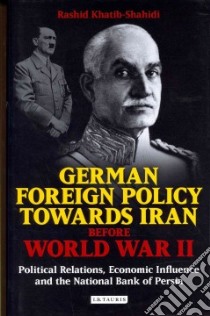- Libreria
- >
- Libri in lingua
- >
- Politica
- >
- Relazioni internazionali
German Foreign Policy Towards Iran Before World War II - 9781848853249
Un libro in lingua di Khatib Shahidi Rashid Armin edito da Tauris Academic Studies, 2013
- € 58.10
- Il prezzo è variabile in funzione del cambio della valuta d’origine
Early twentieth century Iran had been dominated by the competing influences of the two great imperial powers of the time - Russia and Britain. But an emergent, highly industrialised and assertive Germany in the 1930s became an attractive ally through which Iran could cut loose from domination by Britain and the Soviet Union, allowing it to seek modernity outside the constraints of old imperial interests. It was the National Bank of Persia, established in 1927 under German management ,and with Kurt Lindenblatt as its governor, that was to be the vehicle for Germany's economic expansion into Persia. The bank was a vital engine driving industrialization even after Lindenblatt retired and was followed by Gholam Reza Amir-Khosravi and a board of directors including Hossein Ala and Abdul Hossein Hazhir. By World War II, Reza Shah's Iran and Hitler's Germany had developed close commercial ties. But this was a relationship that came to an abrupt end with the Allied invasion of Iran in 1941. Thereafter the Bank came to be known by its Persian name - the Bank Melli-e Iran - which became the country's Central Bank until 1960 and continues as a commercial bank to this day. Delving into previously untapped primary sources, Khatib-Shahidi explores the nature of German involvement in Iran in the inter-war period, examining how it came to be moulded by a handful of individuals - such as Abdul Hossain Taimurtash.
Informazioni bibliografiche
- Titolo del Libro in lingua: German Foreign Policy Towards Iran Before World War II
- Sottotitolo: Political Relations, Economic Influence and the National Bank of Persia
- Lingua: English
- Autori : Khatib Shahidi Rashid Armin
- Editore: Tauris Academic Studies
- Collana: Tauris Academic Studies (Hardcover)
- Data di Pubblicazione: 15 Aprile '13
- Genere: HISTORY
- Pagine: 223
- Dimensioni mm: 209 x 139 x 0
- ISBN-10: 1848853246
- EAN-13: 9781848853249


